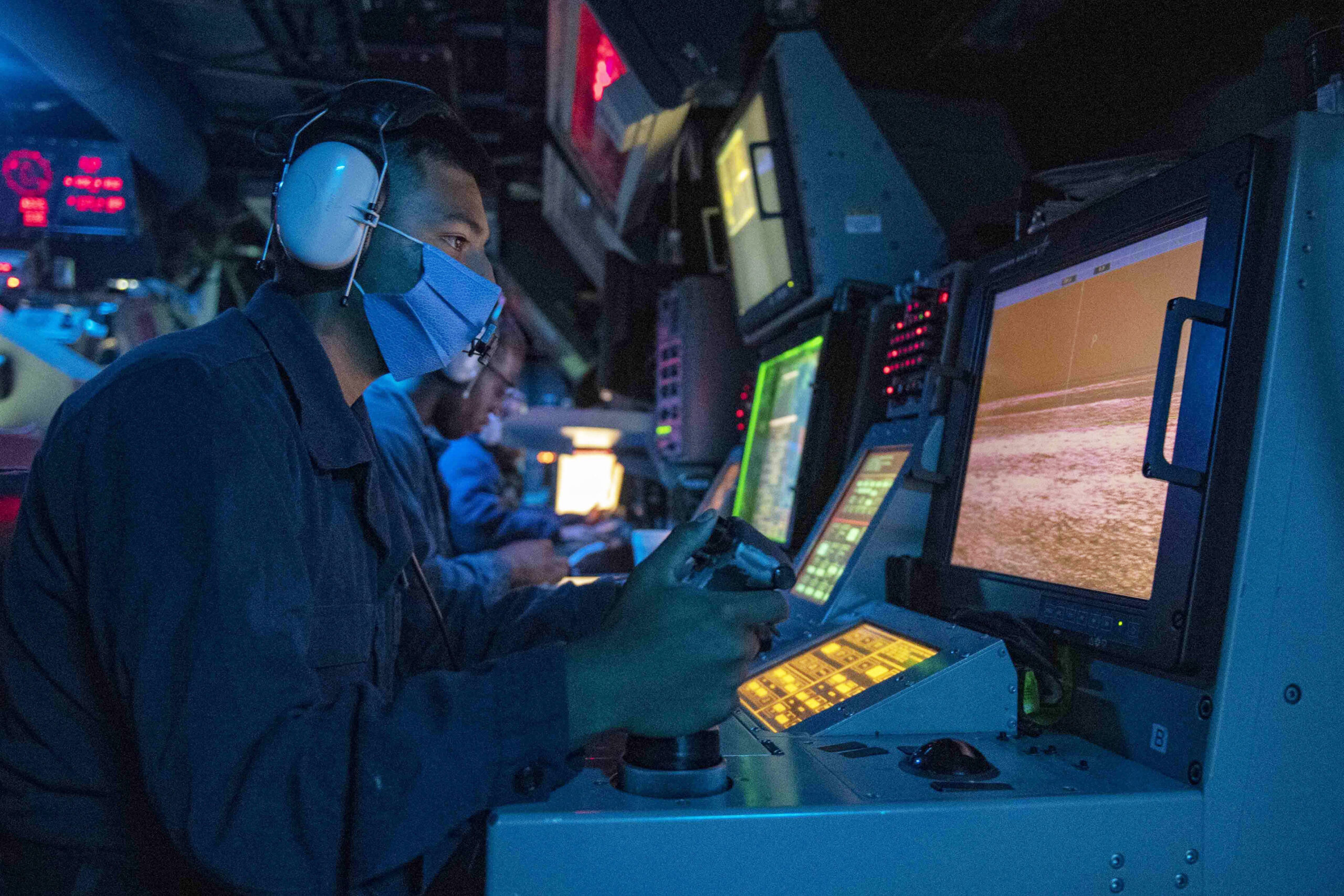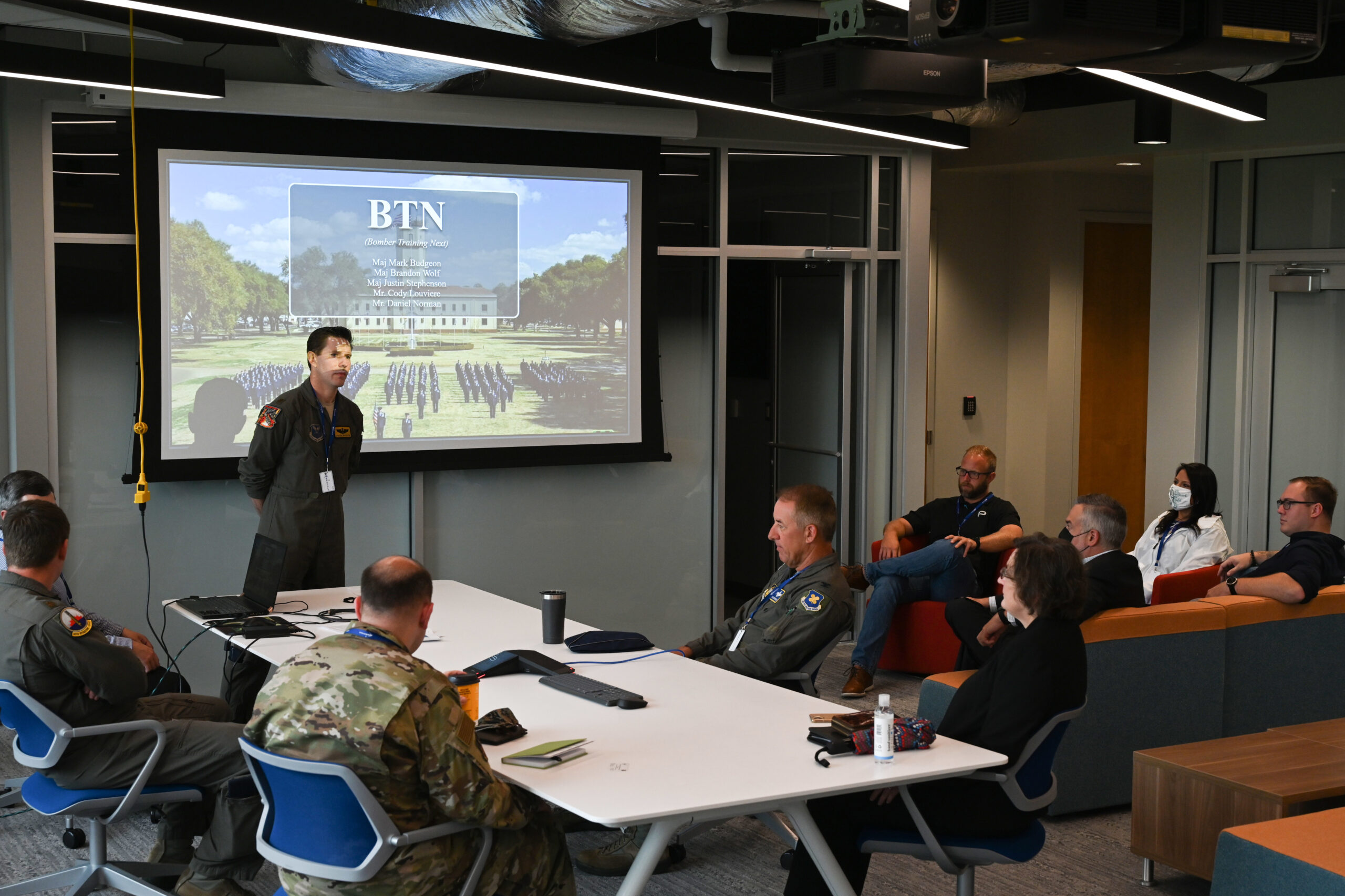It’s time for Congress to ask tough questions about automating combat decision-making before pouring billions of taxpayer dollars into the enterprise, writes Michael T. Klare.

Preston Dunlap, Air Force chief architect, briefs military leaders during first advanced battle management system live demonstration at Eglin Air Force Base, Fla., Dec. 18, 2019. (U.S. Air Force, Joshua J. Garcia)
By Michael T. Klare
TomDispatch.com
 With Covid-19 incapacitating startling numbers of U.S. service members and modern weapons proving increasingly lethal, the American military is relying ever more frequently on intelligent robots to conduct hazardous combat operations. Such devices, known in the military as “autonomous weapons systems,” include robotic sentries, battlefield-surveillance drones and autonomous submarines.
With Covid-19 incapacitating startling numbers of U.S. service members and modern weapons proving increasingly lethal, the American military is relying ever more frequently on intelligent robots to conduct hazardous combat operations. Such devices, known in the military as “autonomous weapons systems,” include robotic sentries, battlefield-surveillance drones and autonomous submarines.
So far, in other words, robotic devices are merely replacing standard weaponry on conventional battlefields. Now, however, in a giant leap of faith, the Pentagon is seeking to take this process to an entirely new level — by replacing not just ordinary soldiers and their weapons, but potentially admirals and generals with robotic systems.
Admittedly, those systems are still in the development stage, but the Pentagon is now rushing their future deployment as a matter of national urgency. Every component of a modern general staff — including battle planning, intelligence-gathering, logistics, communications, and decision-making — is, according to the Pentagon’s latest plans, to be turned over to complex arrangements of sensors, computers, and software.
All these will then be integrated into a “system of systems,” now dubbed the Joint All-Domain Command-and-Control, or JADC2 (since acronyms remain the essence of military life). Eventually, that amalgam of systems may indeed assume most of the functions currently performed by American generals and their senior staff officers.
The notion of using machines to make command-level decisions is not, of course, an entirely new one. It has, in truth, been a long time coming. During the Cold War, following the introduction of intercontinental ballistic missiles (ICBMs) with extremely short flight times, both military strategists and science-fiction writers began to imagine mechanical systems that would control such nuclear weaponry in the event of human incapacity.
In Stanley Kubrick’s satiric 1964 movie Dr. Strangelove, for example, the fictional Russian leader Dimitri Kissov reveals that the Soviet Union has installed a “doomsday machine” capable of obliterating all human life that would detonate automatically should the country come under attack by American nuclear forces.
Efforts by crazed anti-Soviet U.S. Air Force officers to provoke a war with Moscow then succeed in triggering that machine and so bring about human annihilation. In reality, fearing that they might experience a surprise attack of just this sort, the Soviets later did install a semi-automatic retaliatory system they dubbed “Perimeter,” designed to launch Soviet ICBMs in the event that sensors detected nuclear explosions and all communications from Moscow had been silenced.
Some analysts believe that an upgraded version of Perimeter is still in operation, leaving us in an all-too-real version of a Strangelovian world.

Model of the war room constructed for Stanley Kubrick’s Dr. Strangelove.
(China Crisis, CC BY-SA 3.0, Wikimedia Commons)
In yet another sci-fi version of such automated command systems, the 1983 film WarGames, starring Matthew Broderick as a teenage hacker, portrayed a supercomputer called the War Operations Plan Response, or WOPR (pronounced “whopper”) installed at the North American Aerospace Command (NORAD) headquarters in Colorado.
When the Broderick character hacks into it and starts playing what he believes is a game called “World War III,” the computer concludes an actual Soviet attack is underway and launches a nuclear retaliatory response. Although fictitious, the movie accurately depicts many aspects of the U.S. nuclear command-control-and-communications (NC3) system, which was then and still remains highly automated.
Such devices, both real and imagined, were relatively primitive by today’s standards, being capable solely of determining that a nuclear attack was under way and ordering a catastrophic response. Now, as a result of vast improvements in artificial intelligence (AI) and machine learning, machines can collect and assess massive amounts of sensor data, swiftly detect key trends and patterns, and potentially issue orders to combat units as to where to attack and when.
Time Compression & Human Fallibility
The substitution of intelligent machines for humans at senior command levels is becoming essential, U.S. strategists argue, because an exponential growth in sensor information combined with the increasing speed of warfare is making it nearly impossible for humans to keep track of crucial battlefield developments.
If future scenarios prove accurate, battles that once unfolded over days or weeks could transpire in the space of hours, or even minutes, while battlefield information will be pouring in as multitudinous data points, overwhelming staff officers. Only advanced computers, it is claimed, could process so much information and make informed combat decisions within the necessary timeframe.
Such time compression and the expansion of sensor data may apply to any form of combat, but especially to the most terrifying of them all, nuclear war. When ICBMs were the principal means of such combat, decision-makers had up to 30 minutes between the time a missile was launched and the moment of detonation in which to determine whether a potential attack was real or merely a false satellite reading (as did sometimes occur during the Cold War).
Now, that may not sound like much time, but with the recent introduction of hypersonic missiles, such assessment times could shrink to as little as five minutes. Under such circumstances, it’s a lot to expect even the most alert decision-makers to reach an informed judgment on the nature of a potential attack. Hence the appeal (to some) of automated decision-making systems.
“Attack-time compression has placed America’s senior leadership in a situation where the existing NC3 system may not act rapidly enough,” military analysts Adam Lowther and Curtis McGiffin argued at War on the Rocks, a security-oriented website. “Thus, it may be necessary to develop a system based on artificial intelligence, with predetermined response decisions, that detects, decides, and directs strategic forces with such speed that the attack-time compression challenge does not place the United States in an impossible position.”

Standing watch over the optical-sighting-system in the combat information center as the guided missile destroyer USS Mustin conducts routine operations in the Taiwan Strait, Aug. 18, 2020. (U.S. Navy, Cody Beam)
This notion, that an artificial intelligence-powered device — in essence, a more intelligent version of the doomsday machine or the WOPR — should be empowered to assess enemy behavior and then, on the basis of “predetermined response options,” decide humanity’s fate, has naturally produced some unease in the community of military analysts (as it should for the rest of us as well).
Nevertheless, American strategists continue to argue that battlefield assessment and decision-making — for both conventional and nuclear warfare — should increasingly be delegated to machines.
“AI-powered intelligence systems may provide the ability to integrate and sort through large troves of data from different sources and geographic locations to identify patterns and highlight useful information,” the Congressional Research Service noted in a November 2019 summary of Pentagon thinking. “As the complexity of AI systems matures,” it added, “AI algorithms may also be capable of providing commanders with a menu of viable courses of action based on real-time analysis of the battlespace, in turn enabling faster adaptation to complex events.”
The key wording there is “a menu of viable courses of action based on real-time analysis of the battlespace.” This might leave the impression that human generals and admirals (not to speak of their commander-in-chief) will still be making the ultimate life-and-death decisions for both their own forces and the planet.
Given such anticipated attack-time compression in future high-intensity combat with China and/or Russia, however, humans may no longer have the time or ability to analyze the battle space themselves and so will come to rely on AI algorithms for such assessments. As a result, human commanders may simply find themselves endorsing decisions made by machines — and so, in the end, become superfluous.
Creating Robot Generals

Maj. Mark Budgeon addresses audience gathered for a milestone demonstration of the Virtual Reality Program Trainer at StrikeWerx in Bossier City, Louisiana, July 7, 2020. (U.S. Air Force, Ted Daigle)
Despite whatever misgivings they may have about their future job security, America’s top generals are moving swiftly to develop and deploy that JADC2 automated command mechanism. Overseen by the Air Force, it’s proving to be a computer-driven amalgam of devices for collecting real-time intelligence on enemy forces from vast numbers of sensor devices (satellites, ground radars, electronic listening posts, and so on), processing that data into actionable combat information, and providing precise attack instructions to every combat unit and weapons system engaged in a conflict — whether belonging to the Army, Navy, Air Force, Marine Corps, or the newly formed Space Force and Cyber Command.
What, exactly, the JADC2 will consist of is not widely known, partly because many of its component systems are still shrouded in secrecy and partly because much of the essential technology is still in the development stage. Delegated with responsibility for overseeing the project, the Air Force is working with Lockheed Martin and other large defense contractors to design and develop key elements of the system.
One such building block is its Advanced Battle Management System (ABMS), a data-collection and distribution system intended to provide fighter pilots with up-to-the-minute data on enemy positions and help guide their combat moves. Another key component is the Army’s Integrated Air and Missile Defense Battle Command System (IBCS), designed to connect radar systems to anti-aircraft and missile-defense launchers and provide them with precise firing instructions.
Over time, the Air Force and its multiple contractors will seek to integrate ABMS and IBCS into a giant network of systems connecting every sensor, shooter, and commander in the country’s armed forces — a military “internet of things,” as some have put it.
To test this concept and provide an example of how it might operate in the future, the Army conducted a live-fire artillery exercise this August in Germany using components (or facsimiles) of the future JADC2 system.
In the first stage of the test, satellite images of (presumed) Russian troop positions were sent to an Army ground terminal, where an AI software program called Prometheus combed through the data to select enemy targets.
Next, another AI program called SHOT computed the optimal match of available Army weaponry to those intended targets and sent this information, along with precise firing coordinates, to the Army’s Advanced Field Artillery Tactical Data System (AFATDS) for immediate action, where human commanders could choose to implement it or not. In the exercise, those human commanders had the mental space to give the matter a moment’s thought; in a shooting war, they might just leave everything to the machines, as the system’s designers clearly intend them to do.
In the future, the Army is planning even more ambitious tests of this evolving technology under an initiative called Project Convergence. From what’s been said publicly about it, Convergence will undertake ever more complex exercises involving satellites, Air Force fighters equipped with the ABMS system, Army helicopters, drones, artillery pieces, and tactical vehicles. Eventually, all of this will form the underlying “architecture” of the JADC2, linking every military sensor system to every combat unit and weapons system — leaving the generals with little to do but sit by and watch.
Why Robot Generals Could Get It Wrong

Army Cyber Protection Team members in 2017 during a “surge week,” which were first used by software and system developers in Silicon Valley to gather user feedback about system functionality. (U.S. Army)
Given the complexity of modern warfare and the challenge of time compression in future combat, the urge of American strategists to replace human commanders with robotic ones is certainly understandable.
Robot generals and admirals might theoretically be able to process staggering amounts of information in brief periods of time, while keeping track of both friendly and enemy forces and devising optimal ways to counter enemy moves on a future battlefield. But there are many good reasons to doubt the reliability of robot decision-makers and the wisdom of using them in place of human officers.
To begin with, many of these technologies are still in their infancy, and almost all are prone to malfunctions that can neither be easily anticipated nor understood. And don’t forget that even advanced algorithms can be fooled, or “spoofed,” by skilled professionals.
In addition, unlike humans, AI-enabled decision-making systems will lack an ability to assess intent or context. Does a sudden enemy troop deployment, for example, indicate an imminent attack, a bluff, or just a normal rotation of forces?
Human analysts can use their understanding of the current political moment and the actors involved to help guide their assessment of the situation. Machines lack that ability and may assume the worst, initiating military action that could have been avoided.
Such a problem will only be compounded by the “training” such decision-making algorithms will undergo as they are adapted to military situations. Just as facial recognition software has proved to be tainted by an over-reliance on images of white males in the training process — making them less adept at recognizing, say, African-American women — military decision-making algorithms are likely to be distorted by an over-reliance on the combat-oriented scenarios selected by American military professionals for training purposes.
“Worst-case thinking” is a natural inclination of such officers — after all, who wants to be caught unprepared for a possible enemy surprise attack? — and such biases will undoubtedly become part of the “menus of viable courses of action” provided by decision-making robots.
Once integrated into decision-making algorithms, such biases could, in turn, prove exceedingly dangerous in any future encounters between U.S. and Russian troops in Europe or American and Chinese forces in Asia. A clash of this sort might, after all, arise at any time, thanks to some misunderstanding or local incident that rapidly gains momentum — a sudden clash between U.S. and Chinese warships off Taiwan, for example, or between American and Russian patrols in one of the Baltic states.
Neither side may have intended to ignite a full-scale conflict and leaders on both sides might normally move to negotiate a cease-fire. But remember, these will no longer simply be human conflicts. In the wake of such an incident, the JADC2 could detect some enemy move that it determines poses an imminent risk to allied forces and so immediately launch an all-out attack by American planes, missiles, and artillery, escalating the conflict and foreclosing any chance of an early negotiated settlement.
Such prospects become truly frightening when what’s at stake is the onset of nuclear war. It’s hard to imagine any conflict among the major powers starting out as a nuclear war, but it’s far easier to envision a scenario in which the great powers — after having become embroiled in a conventional conflict — reach a point where one side or the other considers the use of atomic arms to stave off defeat.
American military doctrine, in fact, has always held out the possibility of using so-called tactical nuclear weapons in response to a massive Soviet (now Russian) assault in Europe. Russian military doctrine, it is widely assumed, incorporates similar options. Under such circumstances, a future JADC2 could misinterpret enemy moves as signaling preparation for a nuclear launch and order a pre-emptive strike by U.S. nuclear forces, thereby igniting World War III.
War is a nasty, brutal activity and, given almost two decades of failed conflicts that have gone under the label of “the war on terror,” causing thousands of American casualties (both physical and mental), it’s easy to understand why robot enthusiasts are so eager to see another kind of mentality take over American war-making.
As a start, they contend, especially in a pandemic world, that it’s only humane to replace human soldiers on the battlefield with robots and so diminish human casualties (at least among combatants). This claim does not, of course, address the argument that robot soldiers and drone aircraft lack the ability to distinguish between combatants and non-combatants on the battlefield and so cannot be trusted to comply with the laws of war or international humanitarian law — which, at least theoretically, protect civilians from unnecessary harm — and so should be banned.
Fraught as all of that may be on future battlefields, replacing generals and admirals with robots is another matter altogether.
Not only do legal and moral arguments arise with a vengeance, as the survival of major civilian populations could be put at risk by computer-derived combat decisions, but there’s no guarantee that American GIs would suffer fewer casualties in the battles that ensued.
Maybe it’s time, then, for Congress to ask some tough questions about the advisability of automating combat decision-making before this country pours billions of additional taxpayer dollars into an enterprise that could, in fact, lead to the end of the world as we know it.
Maybe it’s time as well for the leaders of China, Russia, and this country to limit or ban the deployment of hypersonic missiles and other weaponry that will compress life-and-death decisions for humanity into just a few minutes, thereby justifying the automation of such fateful judgments.
Michael T. Klare, a TomDispatch regular, is the five-college professor emeritus of peace and world security studies at Hampshire College and a senior visiting fellow at the Arms Control Association. He is the author of 15 books, the latest of which is All Hell Breaking Loose: The Pentagon’s Perspective on Climate Change (Metropolitan Books).
This article is from TomDispatch.com.
The views expressed are solely those of the author and may or may not reflect those of Consortium News.
Please Contribute to Consortium News
on its 25th Anniversary
Donate securely with  PayPal here.
PayPal here.
Or securely by credit card or check by clicking the red button:

There is that old movie, “2001 A Space Odyssey,” where HAL the computer tries to take over. But then ancient history has an even better story. When the Oracle at Delphi told Croesus that if he attacked a great nation would fall, he thought that was great news—so he attacked. Cyrus the Great won though, and Croesus learned that his own great nation was the one to fall, and very sadly, America is a very Croesus- like nation. : (
All generals in an empire are robots. Living or robotic is a useless distinction.
One small step for the military-industrial-security-media complex, and one giant step for Skynet.
Makes you wonder what winning a war actually means when retaliation entails the destruction of humanity.
We could not even get the kinks out of the F-35. How can the techno’s ensure that the war springs controlled by AI will not go horribly wrong? The madness is out of control
It’s like the military-industrial complex is a computer program, that is programmed with the objective and goal to – Waste as much American taxpayers money as possible. It is fantastically, paradoxically efficient at that game. The taxpayers are on the losing end of this war-game scenario every single time.
Decision making by militairy robots will undoubtedly be based on algorithms that take America’s supremacy and exceptional status (as not being subject to any kind of law) as foundation.
It also lays any future blame for war crimes with machines instead of the rogue state that created them – a chilling prospect.
“American GIs” is a dated and inappropriate phrase.
Its use calls up the notion of citizen soldiers in WWII, Bill Mauldin’s sentimental soldiers.
But that’s not what you have today at all in America.
You have a mercenary army, murderously well-equipped, and even organized along especially murderous lines like special forces.
You know, the special forces that in Vietnam used to go out at night, crawling into villages on their bellies to slit the throats of village eiders and officials with knives?
It was called Operation Phoenix, and at least 40, 000 people were killed in that fashion.
Never mind stop the future machines, how about just stopping the killing and destruction you do so much of now almost everywhere?
Appropriate commentary you make.
The reality though, is that there is simply too much money to be made for the killing to stop. A single Tomahawk cruise missile comes in at over a million dollars a unit. In one completely ineffectual missile raid on Syria for example, America expended at least fifty million dollars. Those missiles needed to be restocked and Boeing made a killing – pardon the pun – on that one single raid.
There will be peace when there is no more profit in war.
Keep reminding yourself: “It’s only a movie.”
It’s not though, is it?